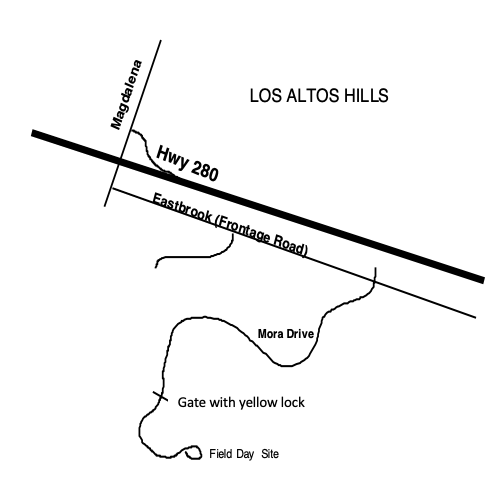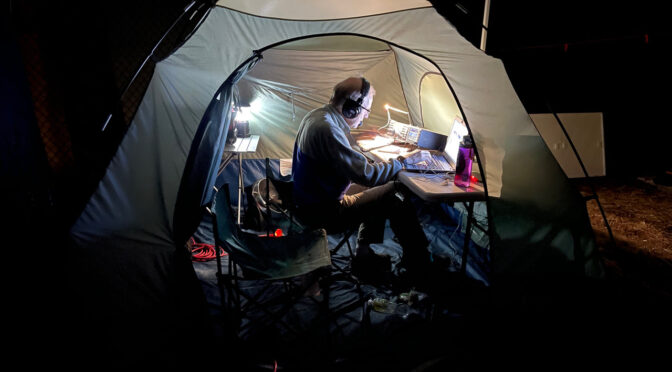Field Day on Mora Hill in Rancho San Antonio Open Space Preserve, June 23-25
WVARA FD Coordinator: Jim Peterson, K6EI
Field Day is a great opportunity to get outdoors, gain experience assembling equipment in the rough, and operate a station under challenging band conditions. This year our club operated QRP in the 12A Battery category from Mora Hill in Rancho San Antonio Open Space Preserve, overlooking the Silicon Valley from an elevation of 500 feet. The weather this year was cool and pleasant — 15 degrees below average for late June!
We had an amazing team on Mora Hill this year, including: W9KKN, N5YJZ, W6IA, K0XI, K9DK, KF6EMB, W6ESL, AD6RY, AK6BY, KK6VF, KM6VHG, KB6NTW, KC7XE, KN6FGH, KN6ZMT, K6XM, KZ2V, KC6LBJ, W6VVQ, AJ6PV, W1MVY, WA2CRQ, and K6BBY.
We had a Get-On-The-Air (GOTA) station, three HF CW stations, three HF SSB stations, three HF digital stations, and five VHF/UHF stations including one with satellite link capabilities. Our GOTA station (W6ZZZ) was particularly popular with plenty of drop-in visitors including a good number of kids, and Mark (W6IA) single-handedly netted us eleven satellite contacts.
Being outdoors also meant that we got to put up wild-n-crazy antennas that our spouses and neighbors would never allow back home. Antennas on Mora Hill this year included a pair of 4-band (10/15/20/40) yagi antennas for CW and SSB, and a traditional tribander (with 40m driven element resonator) for the digital tent. SSB, CW, and Digital each had a triplexer which enabled sharing each yagi between multiple transmitters. We also had separate 80m dipoles for each mode. GOTA had a multiband fan dipole and VHF antennas.
In order to minimize interference within our site, we took care to have HF transceivers with well-designed front-ends in order to minimize spur transmissions and receiver pumping/de-sensing. Most of our site’s HF stations used Elecraft or Flex transceivers. We likewise set up most of our antennas in a line pointed at the East Coast, so the side lobe rejection helped reduce interference. Being QRP further helped control cross-mode interference on each band.
Our digital stations benefited from Bobby K0XI’s van which came with a self-contained 30 foot telescoping mast. In order to minimize interference between the CW and digital stations, we located the digital yagi about 200 feet from the rest of the site. The digital team was able to avoid long runs of coax by installing the digital RF hardware for both of their stations in the van and then running 200 feet of Cat5 Ethernet cable to the main site where the digital tent and the Flex terminals were located.
According to the ARRL’s propagation bulletin, conditions were favorable over Field Day weekend with the exception of a brief period when the planetary K index rose to 5 on Saturday night. The sunspot number on Saturday peaked at 200 (wow!!!) with a solar flux around 160. There was plenty of action on 15 meters, and 20 meters stayed open the entire 24-hours. Sadly, 10 meters band conditions were a bit of a disappointment.
Our projected score of over 27,000 is almost 50% higher than last year’s. And for reference, last year our score placed us at #2 out of roughly 5,000 entries nationwide — second only to the East Coast W3AO mega-station. Not shabby!
It’s never too early to start thinking about FD2024. If you have any thoughts, questions, or would like to get involved with next year’s operation, let me know.
– Jim, K6EI
WVARA Field Day Coordinator
CQFieldDay@gmail.com












WHERE: This year’s Field Day operation will be at the top of Mora Hill located in the San Antonio Open Space Reserve near the Magdalena exit off of Highway 280 in Los Altos Hills. This site overlooks the Silicon Valley from an elevation of 500 feet.

Parking at the Field Day site is limited to those with physical handicaps or vehicles carrying heavy equipment / supplies. For others, we recommend parking nearby in the circled area on this map.

